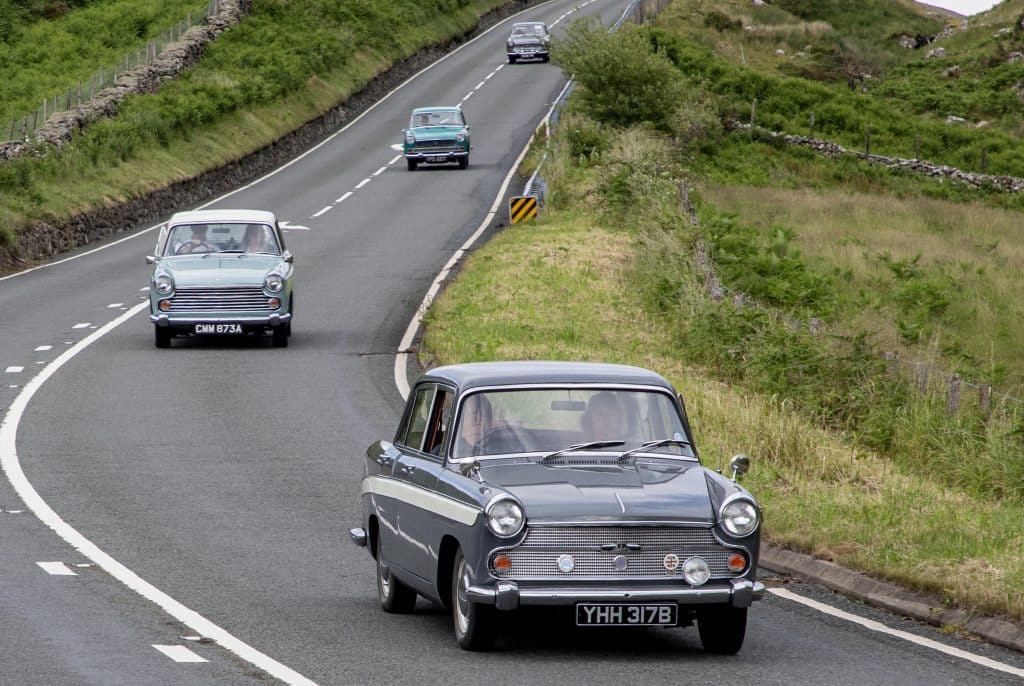Austin’s G.S.5 twins, the Cambridge and Westminster ranges, celebrate their 70th anniversary this year. In this four-part feature, we honour these stylish but mechanically conventional machines which looked smart and up-to-date in 1954 but aged far faster than BMC had envisaged. We also examine how they fit into the wider BMC story, as the basis for two families of Farina-styled badge-engineered cars.

The launch-brochure waxed lyrical about the thoroughness of the development process the car had been subjected to.
In 1954 BMC launched its cars for the newly aspirant post-war middle class, project G.S.5, which appeared as two related cars, the 4-cylinder B-Series powered 1.2 and 1.5-litre Austin Cambridge range and the larger 6-cylinder C-Series-powered 2.6-litre Westminster.

A40, A50,A55 and A105 Vanden Plas at an event in Longbridge in 2017
The pair shared many aspects of the engineering and even some pressings, most notably the doors. They were, however, Austins through and through, built and developed at Longbridge using technology Austin had been developing for several years.

Austin were keen to demystify the design process behind their new cars as this brochure page shows.
They may have been developed by Austin and were launched carrying the Austin name, but they were products of BMC, and that made things much more complex. The announcement that the British Motor Corporation would be created appeared in the press on Friday, November 23rd, 1951, and shocked all but a few insiders. It stated:
‘For some time past the boards of Morris Motors Ltd and the Austin Motor Co Ltd have had under consideration the desirability of amalgamating the two companies. In the result they have arrived at the conclusion that unified control would not only lead to more efficient and economic production, but would also further the export drive, and be particularly beneficial to manufacturing and assembly abroad.
They have formed the opinion, therefore, that amalgamation would be both in the national interest and to the advantage of the shareholders of both companies. Accordingly, they propose a merger of interests…’

BMC made sure the G.S.5 family of cars played its part in Britain’s export drive, something the government were still encouraging to pay back the high national debt accrued in World War 2.
This actually came to pass on March 31st, 1952 (April 1st may have been more appropriate in hindsight?) and was ostensibly, and financially, an equal merger of Britain’s two biggest car makers, the Nuffield Group, which consisted of Morris, MG, Wolseley and Riley, with Austin who only owned one other name, Vanden Plas; a coachbuilder which had not yet become marque in its own right, although the G.S.5-derived family of cars were to play an important part in that process, as we shall see later.

The Nuffield Group’s range of cars as BMC was being created behind the scenes was very diverse and included the by then old fashioned by still elegant MG Y-Type Magnette which shared DNA with the Morris 8.
Although BMC appeared on paper to have been created by a merger of equals, no money or shares having been exchanged to create the new colossus because they were simply pooled, the Austin side of the conglomerate established itself as the dominant partner from the start. Leonard Lord became Chairman and had masterminded the merger from his position at Austin, which he had joined in 1938 after leaving Nuffield in 1936 amid a fierce altercation with William Morris. At this time, he had vowed to “take Morris apart brick by bloody brick” and he made sure of Austin’s pre-eminence within the new company, although the old rivalries continued behind the scenes. This enmity between the groups within BMC continued well into the 1970s, by which time the company had become British Leyland and added Rover, Triumph and Jaguar to the mix; three more companies whose engineers wanted to maintain their independence… But we are getting ahead of ourselves there.

Fiercely protective of BMC and its products Leonard Lord made decisions quickly and often on instinct. He was frequently right, the Mini, the 1100, Mini Cooper and turning Vanden Plas into a marque were all ideas he approved without a single focus group in site. He could be irascible and socially awkward and famously said BMC stood for “Bugger My Competitors”. He is seen above on the right, with Willam Morris on the left.
The post-merger world of the new BMC needed much rationalisation; Nuffield’s products were in some ways more advanced, using rack and pinion steering and OHC engines. Austin’s rival machines, however, were simple, reliable and in favour politically. Their range of more old fashioned ‘pushrod’ A, B and C series engines went from 800cc to 2600cc and had initially been ‘inspired’ by a Chevrolet Truck engine that had been built under licence at Longbridge during the war; the famous ‘Birmingham Bedford’. All three engine families were simple, cheap to manufacture and were also to prove reliable, efficient and tuneable, qualities which made them sensible building blocks for the future. Interestingly the C-Series was not as similar as the A and B were to each other because it was designed at Morris Engines drawing office in Coventry and with major input from one Tadek Merak, who later moved to Aston Martin and created their famous all-alloy straight-six and V8.

The famous BMC B-Series engine, seen here in an A55 MK2 Cambridge, was the backbone of many BMC/BL cars and light commercials including the MGB, ‘1800 Lancrab’, and Sherpa van but it first appeared in its definitive form in the A50 Cambridge.
The Nuffield Group and Austin had long matched each other, building cars that were competitive in the same market and Morris was developing a new range of mid-size cars to compete with Austin’s GS5. Their new mid-size pair utilised the basic idea as Austin, and shared the same under structure to create two cars which also came out in 1954 in the case of the 1.5-litre Oxford, and in 1955 in the case of the 2.6-litre Isis. Both used Austin’s OHV engine rather than the theoretically more advanced OHC units featured in the Nuffield cars they replaced, so BMC were at least starting to rationalise their powertrains.

The 1956 Morris Isis used the same C-series engine as the Austin A90 Westminster but in an unrelated bodyshell.
If, however, you include the Gerald Palmer-designed Wolseley 4/44 (which became the 15/50 when it, inevitably, received the B-Series engine in 1956), and MG Magnette Z-type, BMC went into the second half of the 1950s with three up-to-date mid-size 1.5-litre car families representing four marques. Clearly, there was much rationalising work still to do. No one realised in 1954 but Austin’s G.S.5 would eventually provide the basis for the Farina-bodied cars which would controversially replace all of this diversity with one range of badge-engineered, basically identical cars, distinguished only by different grilles, rear lights and interior styling.

MG’s Z-Type Magnette, seen here in a fetching pale yellow carried MG’s traditional grille and was BMC’s sporting 1.5-litre saloon, while its close relative, the Wolseley 15/50, was aimed at the luxury market.

When, at the 1954 motor show, the Cambridge and Westminster cars were announced by BMC’s newly ennobled Sir Leonard Lord, the Westminster was a complete surprise to the industry who had been expecting the 4-cylinder car but not its larger brother.

The Austin A90 Westminster was often finished in attractive two-tone paint schemes,
At the same time Lord announced that BMC were aiming to make 600,000 cars a year and the two new cars immediately began to contribute to this as they offered good value and were well received, although some journalists politely criticized their woolly steering.

BMC’s adoption of more flamboyant colour schemes was in no small part down to assistance from well-known racing driver and journalist Kay Petre, who worked with Austin in this period as a colour consultant.
They were also pretty new in terms of their mechanical specification, if not actual concept, and must have looked like a good bet to be competitive in the marketplace for many years at the time. Unfortunately for BMC the marketplace moved on apace as rival car manufacturers developed newer designs and motorways came into being faster than anyone had initially predicted. By 1962, the mechanical ‘set’ and floor-pan layout were both outclassed and outdated by newer more efficient machines such as the Ford Cortina, even though they were by then dressed in pretty and fashionable (but even heavier), Farina frocks.

When the A55 was restyled by Pinin Farina it became A55 Mk2 but BMC, for some reason no one has ever really understood, decided to retain the track of the narrower car on which the new model was based, leaving it looking decidedly narrow from the front.

This was corrected when the model was heavily facelifted into the more restrained A60 three years later.
The Cambridge-Oxford Owners Club caters for over 30 seemingly disparate classic cars wearing seven different marque names, but all were derived from Austin’s project G.S.5.



